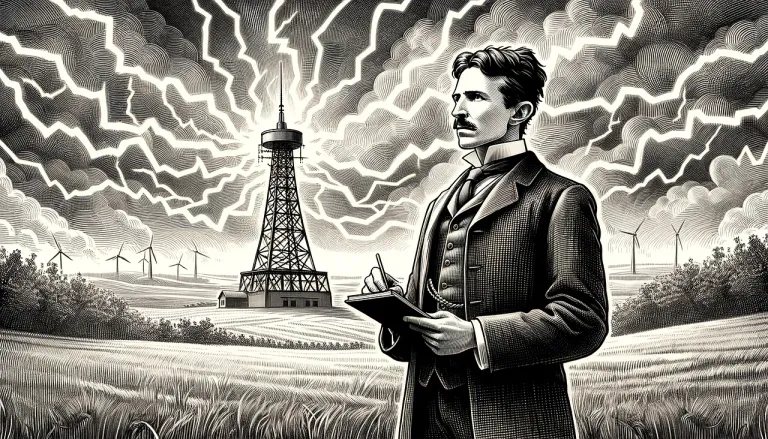The Secret Power of Nikola Tesla’s Earthquake Machine: Fact, Fiction, or Forgotten Invention?

The Man Behind the Mystery
Nikola Tesla was no ordinary inventor. Known for his eccentric brilliance and a mind that often outpaced his time, Tesla gifted the modern world with technologies like alternating current, the Tesla coil, and wireless communication. But among the many remarkable, and sometimes controversial, ideas attributed to him, one stands out for its strange combination of science fiction and frightening potential: the so-called Earthquake Machine.
This mysterious device has captured imaginations for over a century. Stories of shaking buildings, fleeing neighbors, and police intervention have only added fuel to the legend. But is there any truth behind it? Did Tesla create a device capable of simulating an earthquake? And if so, what became of it?
Let’s break it down piece by piece.
The Core Idea: Resonance
To understand Tesla’s Earthquake Machine, we need to begin with the concept of resonance. In physics, resonance happens when a system vibrates at a specific frequency, and that vibration becomes amplified when exposed to an external force that matches its natural frequency. Think of pushing a child on a swing. If you push at the right moment, matching the swing’s natural rhythm, it goes higher and higher. If you push at the wrong time, the swing stalls.
Tesla believed this principle could be applied to structures, machinery, and even the Earth itself. If you knew the resonant frequency of a building, and you had a device that could tap into that rhythm with precise pulses, you could make the entire building vibrate, and potentially collapse. Not through brute force, but through harmonics.
The Oscillator: Small Device, Big Effect
In the 1890s, Tesla developed a small mechanical oscillator powered by steam. It was a compact device, not much larger than a book, and it used a simple piston mechanism to create rhythmic vibrations.
According to Tesla, this oscillator could be tuned to the frequency of nearby structures. And in one of the most famous stories tied to the invention, he attached it to a metal support beam in his New York City laboratory. Moments later, the building began to tremble. The vibrations intensified, and reportedly, things started falling off shelves. Neighbors ran out of their apartments, thinking an earthquake was occurring. Eventually, Tesla had to smash the device with a hammer to stop it.
Whether this story is entirely accurate or not, it demonstrates Tesla’s core belief: that mechanical resonance could be harnessed with relatively little energy to create massive effects.
1935 Interview: Tesla Speaks
Years later, in 1935, Tesla gave an interview to a reporter at the New York World-Telegram. During this conversation, he claimed that his mechanical oscillator, if scaled properly, could split the Earth in two.
Here’s the quote that made headlines: "I could shake the Earth to its very core." He spoke of sending shockwaves through the Earth’s crust by hitting its natural frequency. While that may sound like the words of a mad scientist, Tesla was not known for careless exaggeration. He deeply believed in the potential of resonance and vibration as untapped forces in engineering.
Still, no blueprint, schematic, or physical version of this large-scale device has ever surfaced.
Fact or Fiction?
There are several reasons to believe Tesla’s earthquake machine had a real basis in physics:
Resonance is a proven phenomenon. Bridges and buildings can collapse if struck by rhythmic forces. The Tacoma Narrows Bridge disaster in 1940 is a real-world example. Tesla had a deep understanding of mechanical vibrations. His other inventions, including vibrational therapeutic devices, were built on similar principles. The machine was small, simple, and mechanically elegant, just the kind of invention Tesla favored.
However, skepticism remains: There’s no photographic evidence or surviving prototype of the original oscillator. The eyewitness accounts of the "earthquake" may have been exaggerated or misremembered. Tesla’s later years were marked by grand claims that didn’t always materialize.
Still, the concept itself remains scientifically sound, even if the effects Tesla described were likely overstated.
Why It Matters Today
Tesla’s Earthquake Machine raises questions that remain relevant: Could controlled resonance be used in modern engineering, for energy, demolition, or even seismic research? How do we evaluate fringe ideas that lie between science and pseudoscience? Are we missing other inventions that Tesla developed but never commercialized or published?
The idea of using mechanical resonance to alter physical structures or manipulate energy remains largely unexplored in mainstream science. But with modern tools and data, perhaps Tesla’s forgotten inventions could inspire new research.
The Legacy of a Forgotten Invention
Whether the Earthquake Machine was a misunderstood experiment, a dramatized tale, or a glimpse into a deeper scientific principle, it highlights something important about Tesla:
He didn’t see the world the way most people did. Where others saw rigid matter, he saw vibrations and frequency. Where others used brute force, he looked for rhythm and harmony. His Earthquake Machine may never have toppled skyscrapers or cracked the planet open, but it continues to rattle the boundaries between what we believe is possible and what lies just beyond our understanding.
And maybe, the Earth isn’t the only thing that needs a shake once in a while.
More Than a Myth
The story of Nikola Tesla’s Earthquake Machine is more than a curiosity. It’s a reminder that innovation often lives at the edge of belief. Tesla’s oscillator, real or exaggerated, was rooted in real science and real ambition. And while the machine itself may never have caused an actual earthquake, its legacy still reverberates in the minds of those daring enough to ask: what if?
If nothing else, Tesla proved that sometimes, the smallest vibrations can leave the biggest impact.
Posted by Waivio guest: @waivio_cosmicsecrets
